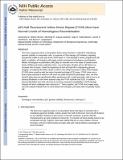| dc.contributor.author | Wiktor-Brown, Dominika M. | |
| dc.contributor.author | Sukup-Jackson, Michelle R. | |
| dc.contributor.author | Fakhraldeen, Saja A. | |
| dc.contributor.author | Hendricks, Carrie A. | |
| dc.contributor.author | Engelward, Bevin P. | |
| dc.date.accessioned | 2014-08-15T14:13:17Z | |
| dc.date.available | 2014-08-15T14:13:17Z | |
| dc.date.issued | 2011-12 | |
| dc.date.submitted | 2011-09 | |
| dc.identifier.issn | 15687864 | |
| dc.identifier.uri | http://hdl.handle.net/1721.1/88709 | |
| dc.description.abstract | The tumor suppressor p53 is a transcription factor whose function is critical for maintaining genomic stability in mammalian cells. In response to DNA damage, p53 initiates a signaling cascade that results in cell cycle arrest, DNA repair or, if the damage is severe, programmed cell death. In addition, p53 interacts with repair proteins involved in homologous recombination. Mitotic homologous recombination (HR) plays an essential role in the repair of double-strand breaks (DSBs) and broken replication forks. Loss of function of either p53 or HR leads to an increased risk of cancer. Given the importance of both p53 and HR in maintaining genomic integrity, we analyzed the effect of p53 on HR in vivo using Fluorescent Yellow Direct Repeat (FYDR) mice as well as with the sister chromatid exchange (SCE) assay. FYDR mice carry a direct repeat substrate in which an HR event can yield a fluorescent phenotype. Here, we show that p53 status does not significantly affect spontaneous HR in adult pancreatic cells in vivo or in primary fibroblasts in vitro when assessed using the FYDR substrate and SCEs. In addition, primary fibroblasts from p53 null mice do not show increased susceptibility to DNA damage-induced HR when challenged with mitomycin C. Taken together, the FYDR assay and SCE analysis indicate that, for some tissues and cell types, p53 status does not greatly impact HR. | en_US |
| dc.description.sponsorship | National Institute of Environmental Health Sciences (ES02109) | en_US |
| dc.description.sponsorship | National Cancer Institute (U.S.) (R33CA112151) | en_US |
| dc.description.sponsorship | National Cancer Institute (U.S.) (R01CA79827) | en_US |
| dc.description.sponsorship | United States. Dept. of Energy (DE-FG01-04ER04-21) | en_US |
| dc.description.sponsorship | National Institute of Environmental Health Sciences (T32 ES007020, NIEHS Training Grant in Environmental Toxicology) | en_US |
| dc.description.sponsorship | National Science Foundation (U.S.) (Fellowship) | en_US |
| dc.language.iso | en_US | |
| dc.publisher | Elsevier B.V. | en_US |
| dc.relation.isversionof | http://dx.doi.org/10.1016/j.dnarep.2011.09.009 | en_US |
| dc.rights | Creative Commons Attribution-Noncommercial-Share Alike | en_US |
| dc.rights.uri | http://creativecommons.org/licenses/by-nc-sa/4.0/ | en_US |
| dc.source | PMC | en_US |
| dc.title | p53 null Fluorescent Yellow Direct Repeat (FYDR) mice have normal levels of homologous recombination | en_US |
| dc.type | Article | en_US |
| dc.identifier.citation | Wiktor-Brown, Dominika M., Michelle R. Sukup-Jackson, Saja A. Fakhraldeen, Carrie A. Hendricks, and Bevin P. Engelward. “P53 Null Fluorescent Yellow Direct Repeat (FYDR) Mice Have Normal Levels of Homologous Recombination.” DNA Repair 10, no. 12 (December 2011): 1294–1299. | en_US |
| dc.contributor.department | Massachusetts Institute of Technology. Department of Biological Engineering | en_US |
| dc.contributor.mitauthor | Wiktor-Brown, Dominika M. | en_US |
| dc.contributor.mitauthor | Sukup-Jackson, Michelle R. | en_US |
| dc.contributor.mitauthor | Fakhraldeen, Saja A. | en_US |
| dc.contributor.mitauthor | Hendricks, Carrie A. | en_US |
| dc.contributor.mitauthor | Engelward, Bevin P. | en_US |
| dc.relation.journal | DNA Repair | en_US |
| dc.eprint.version | Author's final manuscript | en_US |
| dc.type.uri | http://purl.org/eprint/type/JournalArticle | en_US |
| eprint.status | http://purl.org/eprint/status/PeerReviewed | en_US |
| dspace.orderedauthors | Wiktor-Brown, Dominika M.; Sukup-Jackson, Michelle R.; Fakhraldeen, Saja A.; Hendricks, Carrie A.; Engelward, Bevin P. | en_US |
| mit.license | OPEN_ACCESS_POLICY | en_US |
| mit.metadata.status | Complete | |
